There are at
least 78 species of Old World monkeys in two subfamilies---the
Cercopithecinae
 and the Colobinae
and the Colobinae
 .
Monkeys in both groups are relatively large, being about the size of small to
medium-size dogs.
.
Monkeys in both groups are relatively large, being about the size of small to
medium-size dogs.
Cercopithecinae
Most Old
World monkeys are cercopithecines
 .
Included in this subfamily are the baboons
.
Included in this subfamily are the baboons
 ,
mangabeys
,
mangabeys
 ,
mandrills
,
mandrills
 ,
guenons
,
guenons
 ,
patas monkeys
,
patas monkeys
 , and
macaques
, and
macaques
 . These are all African species with the
exception of the macaques which also live in Asia and Gibraltar.
. These are all African species with the
exception of the macaques which also live in Asia and Gibraltar.

|
|
 |
Macaque
(Japan) |
Patas
monkey
(Africa) |
Many species of
cercopithecines sleep in trees or on cliff faces and
spend their days in large groups foraging for food on grasslands.
Among the most
familiar of these semi-terrestrial monkeys are
several species of African baboons.
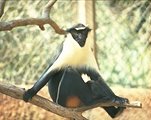
|
|
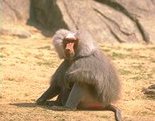 |
Diana guenon
(Africa) |
Hamadryas
baboon
(Africa) |
The
semi-terrestrial cercopithecines are usually very sexually
dimorphic. In these species, adult males are often twice as large as females and
much more aggressive. Male savanna baboons grow up to 80 pounds
(36.3 kg.) and have powerful
jaws with long canine teeth. These are effective
weapons in defense against predators and competition
with other males for mates.
| |
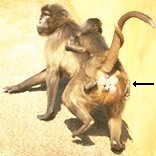 |
Ischial callosities
(gelada baboons)
|
The
cercopithecines share two other identifiable anatomical characteristics--ischial callosities and
cheek
pouches. The latter are cheeks that expand rather like those of hamsters to allow
the secure temporary storage of food. This is a useful trait for these omnivorous monkeys since they compete with each
other for desirable foods and are not inclined to share.
Fruit and meat are particularly prized. Large male baboons
aggressively hunt other monkeys, young chimpanzees, and even flamingos for
food.
The females in some of the cercopithecine species develop prominent
sexual skins around the
time of ovulation. This is a signal to males that they are sexually
receptive.
The most biologically
successful monkeys are the macaques. They occupy the widest range of
environments from the dry grasslands of Africa to tropical forests of South
Asia and cold temperate mountains of Japan. There are at least 21
species of them. The majority of medical research monkeys are rhesus
macaques which were originally from India but now are raised on monkey farms
and labs around the world. More is known about the anatomy,
physiology, and behavior of rhesus macaques than any other primate except
for humans. The Rh blood type system was even named after them.
Colobinae
The second
subfamily of Old World monkeys, the Colobinae, include the
colobus
 of
Africa, and the South Asian langurs
of
Africa, and the South Asian langurs
 and
proboscis monkeys
and
proboscis monkeys
 . All of them are herbivores.
. All of them are herbivores.
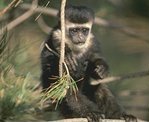
|
|
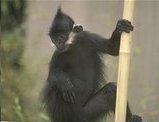 |
Juvenile colobus
(Africa) |
Francois's langur
(South Asia) |
|
|
Male
proboscis
monkey
(Borneo)
|
 |
The
colobines
 lack
cheek pouches. They also share in common the fact that they have
sacculated
lack
cheek pouches. They also share in common the fact that they have
sacculated
 stomachs. That is to say, their stomachs have
"saccules," or sack-like compartments, in which bacteria
and unusual combinations of enzymes break down plant
cellulose, thereby providing more useable calories.
Their stomachs also contain more acid than do those of other monkeys.
This speeds up digestion but
results in delicate stomachs. The Colobinae have
unusually long intestines that increase the absorption of nutrients. These are
all
adaptations to a predominantly low protein, fibrous leaf diet.
Not surprisingly, the Colobinae are also referred to as the
"leaf-eating monkeys." Among Vietnamese
douc langurs and some other colobine species, their abdomens are often
swollen from intestinal gas, making even males appear to be pregnant.
stomachs. That is to say, their stomachs have
"saccules," or sack-like compartments, in which bacteria
and unusual combinations of enzymes break down plant
cellulose, thereby providing more useable calories.
Their stomachs also contain more acid than do those of other monkeys.
This speeds up digestion but
results in delicate stomachs. The Colobinae have
unusually long intestines that increase the absorption of nutrients. These are
all
adaptations to a predominantly low protein, fibrous leaf diet.
Not surprisingly, the Colobinae are also referred to as the
"leaf-eating monkeys." Among Vietnamese
douc langurs and some other colobine species, their abdomens are often
swollen from intestinal gas, making even males appear to be pregnant.
The proboscis ("nose")
monkeys of Borneo have a peculiar form of sexual dimorphism. Adult
males develop a long Pinocchio-like nose.
Review
of Monkey Classification
Let us take a moment
to review
the framework of monkey classification. To begin, they are members of the
Haplorrhini suborder along with all of the apes and humans. However, the New World monkeys are
sufficiently different from the others to warrant their placement in a separate
parvorder
(Platyrrhini).
|
MONKEYS: |
|
|
suborder:
|
Haplorrhini (anthropoids) |
|
parvorder:
|
Platyrrhini |
Catarrhini |
|
species:
|
New
World monkeys |
Old World monkeys
apes
humans |
|








